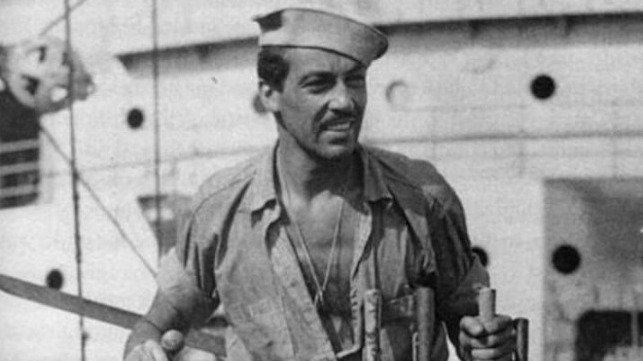Cesar Romero: Hollywood Star, WWII Seaman

[By Nora L. Chidlow]
In the pre-dawn hours of June 15, 1944, American cannon fire fell from the sky and Allied aircraft dived through the air to rain destruction on the Mariana Islands. It was the beginning of the Pacific War’s own D-Day–just days after Normandy. The mission, Operation “Forager,” was to capture the three most important islands in the Marianas chain - Saipan, Guam and Tinian. Two attack forces and one reserve force, comprised of Marine, Navy, and Coast Guard units, were responsible for carrying out the attack
The Marianas are some 3,500 miles from Hawaii, so each Allied ship had to bring everything it needed. There was no way to resupply; no nearby bases for air support; the wounded had to be treated on site; and there was nowhere to fall back. Nonetheless, 25 days later, the three islands were in Allied hands. The flagship of Commander Reserve Transport Group and Commander Transport Division Seven was the Coast Guard-manned transport USS Cavalier. At the winches aboard Cavalier, wholly responsible for transferring landing craft, vehicles and troops in the midst of all the action was Hollywood star Cesar Romero.
Born in New York, on February 15, 1907, Romero was the son of Cesar Romero and Maria Mantilla. His father operated a sugar importing business before the stock market crashed in 1929. His mother was the daughter of famed Cuban national José Martí, who was killed in battle during the liberation of Cuba from Spain. Romero later recounted, “My background is Cuban, but I’m from New York City. I’m a Latin from Manhattan.”
Romero attended school in New York and Connecticut with plans to become a banker. He began that career as a messenger for the Bank of New York, but a chance meeting with New York socialite Elizabeth Higgins changed all that. She needed a dance partner, and the handsome, six-foot-three-inch Romero was happy to oblige.
For most of the late 1920s, Romero danced his way through several East Coast supper clubs. In 1933, he danced in the Broadway show “Dinner at Eight.” The same year, he caught the eye of the small film company New York-based Trojan Pictures, which cast Romero as Tony Rico in the movie “The Shadow Laughs.” The following year, Metro Goldwyn Mayer (MGM) cast Romero as a gigolo in “The Thin Man,” and his film career took off. Romero later admitted, “I was never a leading man, and very seldom did I do a picture where I got the girl.”
Romero starred in nearly 50 films before World War II; however, after the U.S. entered the war, Romero preferred to serve his country rather than acting. On October 22, 1942, he enlisted in the Coast Guard as an apprentice seaman. His enlistment made national headlines.
After 10 weeks at the Coast Guard’s West Coast boot camp, in Alameda, California, Romero boarded the only Coast Guard vessel on which he would serve, the Coast Guard-manned transport Cavalier. His duty was operating deck cranes, swinging 18,000-pound barges and other landing craft from the deck over the side of the vessel during invasions as well as bringing craft and cargo on board. He would reload craft back on board the ship and hoist aboard injured and battle casualties. At general quarters, he also served as “First Powderman” on a forward five-inch gun. He requested that combat duty and got it by beating out competition from men 10 to 20 years his junior.
While in the service, Romero wanted no special treatment and he received none. He took orders and performed his duties. As he would later recall, he “knew the service was going to be tough [but] it [wasn’t] half as bad as expected.” His shipmates admired him for his work ethic and desire to be treated like one of the crew, and not a celebrity.
In the service, Romero rose every morning between 0330 and 0530, swept down his quarters, emptied trash, and got things squared away for the day. He always obeyed orders and slept in ordinary enlisted bunk space. He participated in shipboard recreation, helping put on variety shows for Cavalier’s crew. On liberty, he did what his shipmates did–sightseeing, carousing and visiting local USOs. Romero earned $76 per month in the service and never spent more than his Coast Guard salary. At Saipan, Romero also donated blood to save the lives of wounded marines. As Cavalier’s captain would later say, “he’s a man with an extraordinarily fine character.”
In October 1944, after seeing action at Saipan and Tinian, Cavalier returned to Pearl Harbor. For the remainder of his Coast Guard career, Romero participated in morale events and war bond rallies, often speaking at war production plants. Frequently recognized in his Coast Guard uniform, he would sign countless autographs before his speaking engagements. He also participated in the “Tars & SPARs” radio show with fellow Coast Guard celebrities Rudy Vallee and Janet Blair.
By April 1944, Romero advanced to seaman first class and later made chief boatswain’s mate. He was discharged from the service when the war ended in 1945, and he returned to his career in Hollywood. In 1957, he hosted the television show, "The Beach Pounders," the true story of Nazi saboteurs who landed on a lonely Long Island beach and were captured by the Coast Guard.
Cesar Romero never married. He was best known for his six “Cisco Kid” films of the 1930s and 1940s and his role as “the Joker” on the Batman television series in the 1960s. He passed away in California on January 1, 1994, at the age of 86. He was a Hollywood star, but as a wartime Coast Guardsman, he was just “one of the guys.”
Nora L. Chidlow is an archivist with the United States Coast Guard.
The opinions expressed herein are the author's and not necessarily those of The Maritime Executive.
